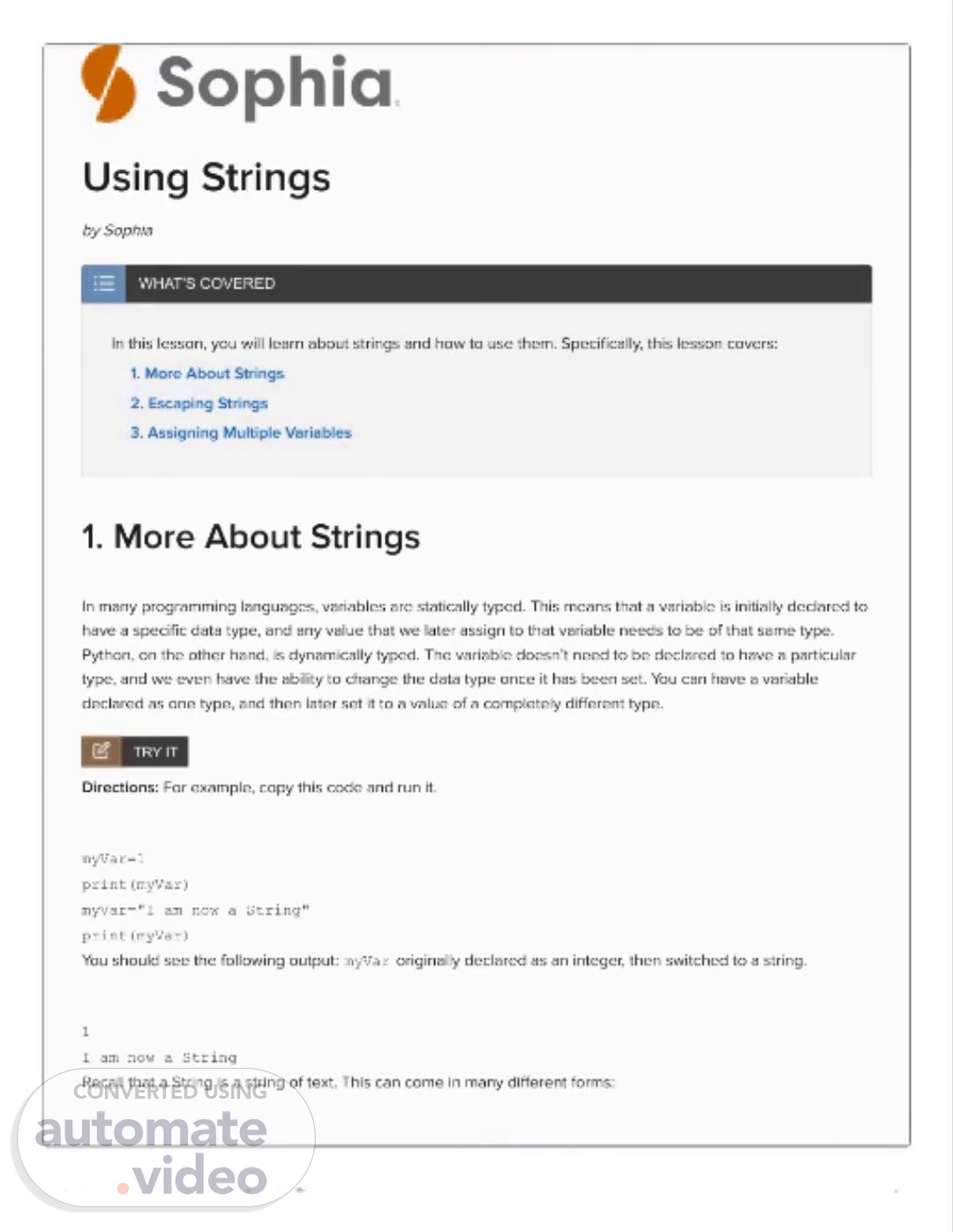Scene 1 (0s)
© 2025 SOPHIA Learning, LLC. SOPHIA is a registered trademark of SOPHIA Learning, LLC. Page 1 Using Strings by Sophia In this lesson, you will learn about strings and how to use them. Specifically, this lesson covers: 1. More About Strings 2. Escaping Strings 3. Assigning Multiple Variables 1. More About Strings In many programming languages, variables are statically typed. This means that a variable is initially declared to have a specific data type, and any value that we later assign to that variable needs to be of that same type. Python, on the other hand, is dynamically typed. The variable doesn’t need to be declared to have a particular type, and we even have the ability to change the data type once it has been set. You can have a variable declared as one type, and then later set it to a value of a completely different type. TRY IT Directions: For example, copy this code and run it. myVar=1 print(myVar) myVar="I am now a String" print(myVar) You should see the following output: myVar originally declared as an integer, then switched to a string. 1 I am now a String Recall that a String is a string of text. This can come in many different forms: WHAT'S COVERED.
Scene 2 (49s)
[Audio] Strings in Python are sequences of characters. They can consist of letters, numbers, symbols, and even empty spaces. Examples of different types of strings include a sentence, a single character, a string with symbols and numbers, and an empty string. An empty string is still considered a string, but it contains nothing. When defining strings in Python, they must be surrounded by quotation marks, either single or double. Be careful not to mismatch them, as this will result in an error. Being able to switch between single and double quotes can be useful, especially when including one of the quotes within the string..
Scene 3 (1m 27s)
[Audio] Strings in Python can be defined using either single quotes or double quotes. When a string contains both single and double quotes, using only one type of quote may not be sufficient. To handle such situations, Python provides the ability to escape special characters within a string. This is done by prefixing the special character with a backslash (). For instance, if we want to include a single quote within a string, we can do so by preceding it with a backslash, as shown below: myString = 'It\'s not working' print(myString) This way, we ensure that the string is properly formatted and avoids any syntax errors..
Scene 4 (2m 11s)
[Audio] To avoid errors when using special characters in a string, it is recommended to escape them. The escape character is a backslash (\) followed by the character that needs to be added. For instance, to include a single quote in a string, you need to precede it with a backslash. The example provided shows how to do this: myString1 = 'It\'s working'. By adding the backslash before the single quote, we can successfully print the string without encountering an error. Similarly, we can use other escape characters such as \n for a new line and \t for a tab. These characters can be used in combination to create more complex output. For example, instead of printing three separate lines, we can combine them into a single print statement using the \n character..
Scene 5 (2m 59s)
[Audio] Strings in Python can be used to represent various types of data such as words, sentences, paragraphs, and even special characters. To include special characters within a string, we need to use an escape character. The escape character is denoted by a backslash (\). When we place the backslash at the end of a line, the backslash and newline are ignored. We can also use the backslash to output the backslash itself, the single quote, the double quote, and the backspace. Furthermore, we can use the backslash to add a new line or a tab to our string. For instance, we can use "\n" to add a new line after each line, and "\t" to add a tab between words. Additionally, we can assign multiple values to multiple variables on a single line, which can be useful in certain situations..
Scene 6 (3m 45s)
[Audio] On this slide, we see that assigning multiple variables to a single value is possible. This is accomplished through repeated use of the assignment operator (=). The code snippet illustrates this concept by assigning the value "We're the same" to three variables: myString1, myString2, and myString3. When printed, these variables produce identical outputs, displaying "We're the same" on three distinct lines. This showcases how assigning multiple variables to the same value can streamline and optimize our code..
